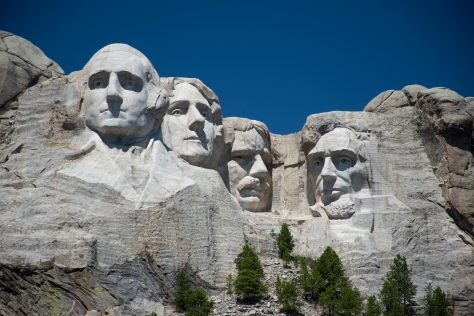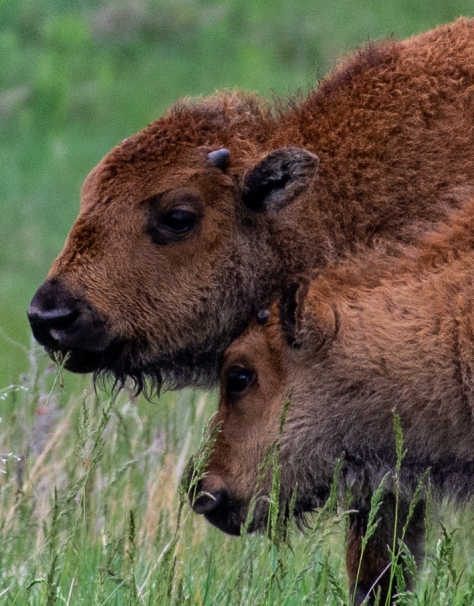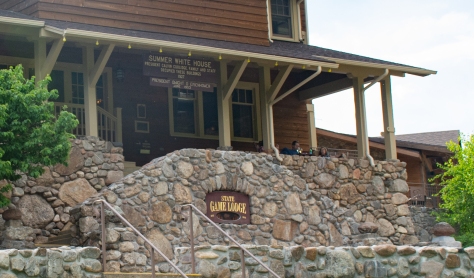Visiting South Dakota State and National Parks on a Road Trip from Minnesota to Wyoming

South Dakota seems synonymous with family road trips, summer vacations and heading “out west.” Every time we drive that direction from Minneapolis, there’s a feeling of anticipation as the landscape gradually changes from hills, to flat prairie, to a more rugged and rocky type of Great Plains geology.
Recently, my husband and I set out like Lewis and Clark to explore South Dakota—only with much more pleasant accommodations in our little Winnebago Rialta RV. Our itinerary ran from east to west along I-90 where we hoped to see stunning rock formations, historic locales, uncrowded spaces and the wildlife for which this region is known. Our journey included stops at three parks: Palisades State Park, Badlands National Park and Custer State Park.

Hitting the plains fires up my imagination with images of rugged pioneers, native Americans and western life–images that came from books I’ve been reading since childhood, starting with Laura Ingalls Wilder’s “Little House on the Prairie” series. In fact, De Smet, where Laura lived as an adult is about an hour and a half north of our first stop in Palisades Park. So if you’re a fan you might want to veer north for a visit. Be sure to read the less happy but more accurate story of Laura’ real life, Prairie Fires (a great for book groups).

Split Rock Creek, the centerpiece of Palisades State Park in eastern South Dakota, isn’t a huge body of water but it’s had an outsized impact on this rocky gem of a spot about 20 miles from Sioux Falls.
Here, the creek cut deep gorges through the billion-year-old Sioux quartzite rock that lines its banks. That resulted in 50-foot vertical cliffs and intricate rock formations that are popular with kayakers, rock climbers and photographers.
Back in the mid-1800s, the rushing creek also powered a flour mill on the bluff that overlooks the park. Starting in 1862, the tiny town of Palisades grew up around the the mill. However, with the promise of free lots, the railroad soon lured businesses away to the nearby town of Garretson where its rail yard was located and the town of Palisades faded away.
Palisades State Park opened in 1972 and has remained one of the South Dakota’s smallest parks—until now. For comparison, at 71,000 acres, Custer State Park at the opposite end of I-90, dwarfs its little cousin, Palisades. But in spring of 2020, about 270 acres were added to the park for a total of nearly 435 acres. Park officials expect to add 75 new camp sites for a total of 109 sites along with more cabins, hiking trails, day use areas, improved habitat for wildlife viewing, and park programs.

Midway across South Dakota, the Badlands gouge through the flat plains with eons-old rock formations that resemble a moonscape. On previous trips to points further west we simply drove through the park for a quick look. We thought it didn’t offer much more than barren (though pretty impressive) rock. This time we stayed for two days. Our hikes and scenic drives revealed not only fascinating geological formations but also plenty of life including wildflowers, agitated prairie dogs and mountain goats galore.
But it surely doesn’t seem like great farmland. That didn’t stop the hopeful homesteaders who arrived in this area after the Homestead Act of 1862 provided the opportunity for folks to head west to acquire land. It was theirs for, say $18 for 160 acres if they lived on it for five years. You can view the some of the land they settled at the Badlands National Park’s Homestead Overlook. Most of the land claims turned into “Starvation Claims” and were abandoned or sold.

Here’s a story I’ll bet you haven’t heard about: African Americans were prominent among the region’s homesteaders. Many were introduced to the area when they were Buffalo Soldiers. You can read about these pioneers in a gripping novel, The Personal History of Rachel Dupree by Ann Weisgarber. The book starts out with a family lowering their little girl down a well to scoop out the last of the water on their drought-stricken farm. It grabbed me from the very start. Also, The Conquest by Oscar Micheaux is a semi-autobiographical novel of a black homesteader in Gregory County during the early 1900’s


We visited on the way to Custer State park we visited South Dakota’s trademark, Mount Rushmore. The four faces appear on promotional material, license plates and have been featured during the Macy’s Thanksgiving Day parade. Cool if you’ve never seen it before, but crowded. We headed to a similarly giant sculpture nearby, the Crazy Horse Memorial, which I liked better because it has a nice little museum and Native American programming.
At the opposite end of I-90, we explored Custer State Park, South Dakota’s largest state park. At 71,000 acres the huge park seems more like a national park. It offers hiking, boating, fishing and plenty of wildlife including bison traffic jams.


One of my favorite hikes was the one up Black Elk Peak, a 7,242-foot granite mountain with an historic stone firetower at the top. It’s considered the highest peak east of the rockies, depending on if you think the 8,749-foot Guadaloupe Peak in Texas is east of the Rockies or part of them . The beginning of the 7.6-mile loop trail is bedazzled with shiny mica rock which makes it look like it’s paved with rhinestones, quite magical.

For non-campers, Custer offers historic lodges and cabins, including State Game Lodge built of native stone and wood in 1920 and listed on the National Register of Historic Places. It served as the “Summer White House” for President Calvin Coolidge in 1927 and was visited by President Dwight D. Eisenhower in 1953. Book ahead and stay in their historic rooms. Even if you’re not staying there, the Lodge welcomes diners in the restaurant and you can carry out food to eat outdoors. We enjoyed cocktails on the Lodge’s front porch before returning to our camp site.
Read Up
Anyone interested in enriching their South Dakota travel experience will find an abundance of great books about both the state’s history and modern life, too. Here’s my list:
Crazy Horse and Custer: The Parallel Life of Two American Warriors–Stephen Ambrose
Dakota : A Spiritual Geography–Kathleen Norris
The Last Stand–Nathaniel Philbrook
Bury My Heart at Wounded Knee–Dee Brown
The Golden Bowl –Frederick Feikema Manfred
Buffalo for the Broken Heart–Dan O’Brien



